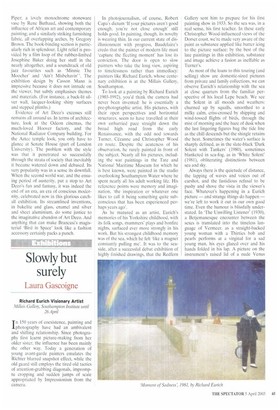Slowly but surely
Laura Gascoigne
Richard Enrich Visionary Artist Millais Gallery, Southampton Institute until 26 April
In 150 years of coexistence, painting and photography have had an ambivalent and shifting relationship. Since photography first learnt picture-making from her older sister, the influence has been mainly the other way. Today a generation of young avant-garde painters emulates the Richter blurred snapshot effect, while the old guard still employs the tired old tactics of attention-grabbing diagonals, impromptu cropping and sudden jumps of scale appropriated by Impressionism from the camera.
In photojournalism, of course, Robert Capa's dictum If your pictures aren't good enough, you're not close enough' still holds good. In painting, though, its novelty is wearing thin. In our current state of disillusionment with progress, Baudelaire's credo that the painter of modern life must 'capture the fleeting moment' has lost its conviction. The door is open to slow painters who take the long view, aspiring to timelessness rather than immediacy: painters like Richard Enrich, whose centenary exhibition is at the Millais Gallery, Southampton.
To look at a painting by Richard Eurich (1903-1992), you'd think the camera had never been invented; he is essentially a pre-photographic artist. His pictures, with their open perspectives and horizontal structures, seem to have travelled at their own unhurried pace straight down the broad high road from the early Renaissance, with the odd nod towards Turner, Cezanne and Christopher Wood en route. Despite the acuteness of his observation, he rarely painted in front of the subject. Nearly all his pictures, including the war paintings in the Tate and National Maritime Museum for which he is best known, were painted in the studio overlooking Southampton Water where he spent nearly all his adult working life. His reference points were memory and imagination, the inspiration or whatever one likes to call it being something quite subconscious that has been experienced perhaps years ago'.
As he matured as an artist, Eurich's memories of his Yorkshire childhood, with its folk songs, mummers' plays and bonfire nights, surfaced ever more strongly in his work. But his strongest childhood memory was of the sea, which he felt 'like a magnet constantly pulling me'. It was to the seaside, after a successful debut exhibition of highly finished drawings, that the Redfern Gallery sent him to prepare for his first painting show in 1933. So the sea was, in a real sense, his first teacher. In these early Christopher Wood-influenced views of the Dorset coast, we're made very aware of the paint as substance applied like butter icing to the picture surface; by the best of the late paintings in this exhibition, substance and image achieve a fusion as ineffable as Turner's.
As most of the loans to this touring (and selling) show are domestic-sized pictures from private and family collections, we can observe Eurich's relationship with the sea at close quarters from the familiar perspective of his local Lepe beach. We see the Solent in all moods and weathers: churned up by squalls, smoothed to a milky calm, criss-crossed by shipping and wind-tossed flights of birds, through the mist of morning and the haze of dusk when the last lingering figures hug the tide line as the chill descends but the shingle retains the heat. Sometimes the water's surface is sharply defined, as in the slate-black 'Dark Solent with Tankers' (1980), sometimes blanketed in sea-fog, as in 'White Solent' (1981), obliterating distinctions between sea and sky.
Always there is the quietude of distance, the lapping of waves and voices out of earshot, and the fastidious refusal to be pushy and shove the vista in the viewer's face. Whatever's happening in a Eurich picture — and strange things do happen — we're left to work it out in our own good time. Even the humour is blissfully understated. In 'The Unwilling Listener' (1930), a Betjemanesque encounter between the sexes is translated into the timeless language of Vermeer, as a straight-backed young woman with a Thirties bob and pearls performs at a virginal for a sad young man, his eyes glazed over and his hands folded in his lap. A picture on the instrument's raised lid of a nude Venus being bunched by Cupid slyly proposes an alternative ending. In 'The Critics' (1956) the humour is sharper and more personal. A group of agitated pundits, all talking at once, discuss the merits of a minimalist abstract in a sombre room, while through an open door into brilliant sunlight we glimpse a vision of a nude model addressing the artist as he shuffles through with a figurative painting, next for dissection.
Witty as it is, The Critics' is uncharacteristic of Eurich. His pictures seldom set out to tell us something; more often they seem to be talking among themselves. Analysing his obsession with the sea. Eurich wrote that he had left something there in childhood and 'gone back to try and recapture it but it just evades me'. His work is an attempt to get to the bottom of things, a rummage through memory in the search for truth. Some of that truth emerges in the image, but some remains embedded in the paint. Which is why, unlike the photographer's frozen moment, Eurich's pictures are always worth another look.
The show travels to Russell-Cotes Art Gallery and Museum, Bournemouth from 10 May to 22 June; and Fine Art Society, London from 14 July to 8 August. Southampton City Art Gallery has a special display of Eurichs in its collection through April.



































































 Previous page
Previous page